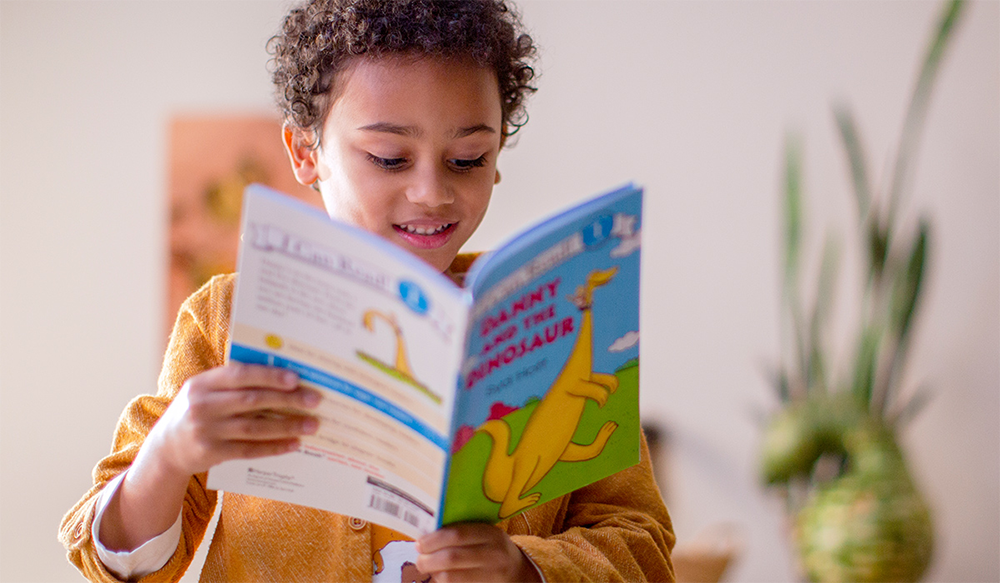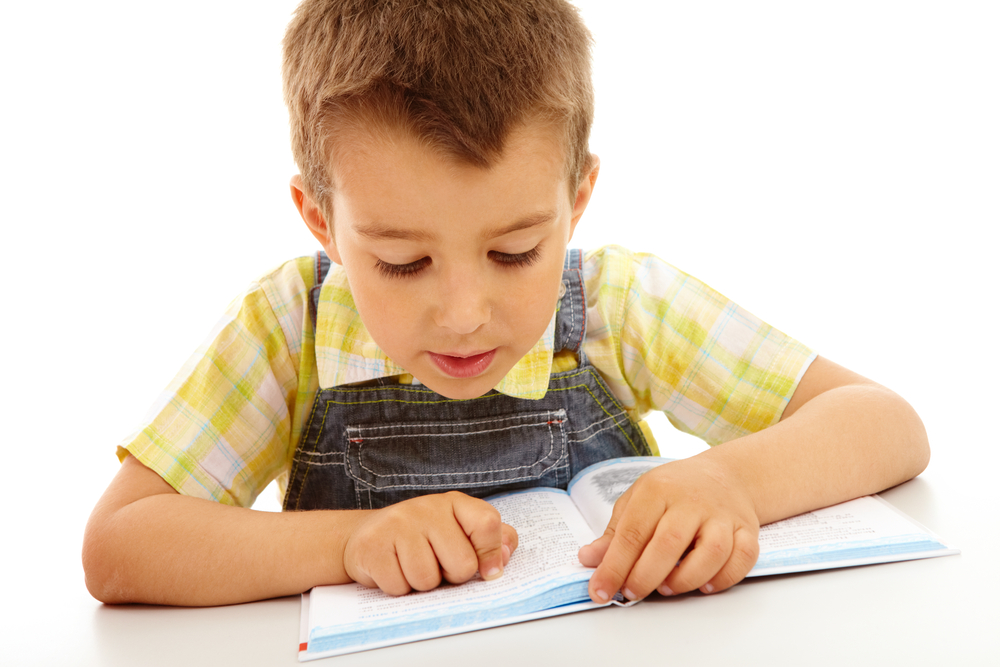Reading fluency, like so many other milestones in a child’s life, is something that can take kids a while to achieve. But with practice, consistency, and patience, your young learner will be on the road to reading fluency!
Our experts at HOMER are here to walk you through what reading fluency is, why it matters, and how to encourage your child down the path toward smooth, confident reading.
What Is Reading Fluency?
Reading fluency describes the level of automation and accuracy a person has while reading. Once your child no longer has to decode, or “sound out,” the majority of the words they encounter and can read smoothly, they’re on their way to reading fluently.
Fluent readers sound natural while reading, as if they’re speaking, and understand phrasing while reading aloud. Think of news anchors reading off a teleprompter. If you didn’t know they had teleprompters, you might think they were just telling you a story!
But that doesn’t mean your child needs to be a news anchor in order to read with fluency. The main goal for your child is to simultaneously recognize and pronounce the words they read while comprehending the information on the page.

Why Is Reading Fluency Important?
Without fluency, reading can be taxing. Stopping to sound out word after word can be exhausting for kids.
Being able to forgo the constant stopping and starting helps alleviate the stress of reading, and reading becomes easier, more effective, and fun!
It’s not uncommon for beginning readers to pay so much attention to saying the words on the page that they fail to give meaning to what they are reading. In other words, there’s a gap in reading comprehension. Reading without comprehension is actually more reciting than reading.
Understanding — reading comprehension — grows alongside children’s reading fluency. When a child no longer has to worry about the accuracy and speed of their reading, they can focus directly on what’s happening in the story.
Maintaining the ability to read on their own (and understand what they read!) will also give your child a confidence boost. Their newfound independence may end up making them want to read more as they explore their own interests or dive into imaginative worlds!

Causes Of Reading Fluency Challenges
Before we cover how to help your child improve their fluency, we must look at why this might be a struggle. There are many reasons why children can have difficulty with reading fluency. Two of the most common are:
They have not learned to decode automatically.
Your child may still sound out words rather than reading decodable words, even ones they have not seen before, instantly.
For example, you can read the word “flimp” automatically because you know how to decode it even though you have never seen it before. This kind of automatic decoding is essential for fluency.
They are not yet familiar with sight words.
We’ll cover how to help your child work on this, but for now, it’s important to note that sight words are the words that come up commonly in texts.
When a child doesn’t recognize them, they may read slowly as they try to sound each of these words out.
They may not comprehend what they are reading.
As children read slowly, the focus may also be on sounding out or decoding words instead of trying to comprehend what they are reading.
If your child is good at recognizing sight words and decoding, that’s great! However, this doesn’t mean that they understand the text. And when they don’t understand the text in front of them, they may struggle to read fluently.
Comprehension also includes having the background knowledge to make sense of what they are reading. A child who does not know anything about the Arctic, for example, will have a harder time reading about polar bears than children who are familiar with this geography.
While these are a few of the most common reasons kids may have trouble with reading fluency, the good news is that there are multiple strategies you can implement at home to help your child. Let’s take a look.
13 Tips To Improve Reading Fluency
Now that we all know what reading fluency is and that it’s critical to your child’s learning journey, where do we begin bringing their fluency to fruition?
Here are a few tips to keep in mind and guide your family’s reading time!
1) Read Aloud To Your Child
This may seem like the most cliche technique in the book, but it’s a cliche for a good reason — it works!
Reading aloud to your child is the surest way to help them know that reading is about meaning. This not only fosters your child’s growth as a book lover, but it also allows them to use reading comprehension to help them develop fluency.
In addition, reading aloud expands children’s vocabulary, and a strong vocabulary is an important aid in fluency, especially after second or third grade.
Having a familiar voice to help and guide your child through stories may also make them more comfortable while they work on their skills.
Reading to your child or engaging in shared reading (you read a page and your child reads the next page) improves a child’s confidence, curiosity, imagination, and prior knowledge — all important things that contribute to reading fluency!
Plus, it’s a great option for what all families need plenty of: relaxation and bonding time. Reading together supports the parent-child bond you have with one another by sharing ideas, stories, and moments together.
When reading to or with your child, try to include some poems with rhyming schemes in the mix. These are beneficial because the repetition of the sounds helps children anticipate the sound at the end of the following line, which can aid in fluency.
Reading poems that rhyme can also help children with letter-sound recognition. This is because the more they read them, the more likely they are to notice that the same letter combinations often make the same sounds.
Another advantage is that children can pick up on how different vowel or consonant pairings can make similar sounds, which may help with word decoding.
Besides helping to achieve important learning goals, children’s poems, riddles, or limericks are also just plain fun! Many are based on interesting topics and offer lots of laughter. And you won’t have to worry about motivating your child to read.

2) Allow Your Child To Pick
There is so much power in allowing your child to control (at least to some extent) their own reading journey.
By encouraging your young reader to select their own books for their daily reading practice, you offer them a direct incentive for investing in their reading time.
Letting your child choose their books also gives you the opportunity to get a better understanding of what books your child loves (and could read more of in the future!).

3) Reread Favorite Books
When your child picks their own book to read, you may run into a situation where they continue to pick the same book multiple days in a row, even if they’ve already read the book several times.
Don’t let the alarm bells sound — this can be a good thing!
By rereading books, your child becomes more familiar with the words (which helps them learn to read those words!) and can begin to engage more deeply with the messages inside the story.
This technique develops your child’s reading comprehension and reading fluency. Their increased comfort with the words in the text and the flow of the story will naturally allow their reading to become more smooth, as they’ll be less concerned about getting the words “right.”
4) Use Word Trees
Word trees help your child focus on one word at a time, then accumulate accuracy and speed until they have the entire sentence mastered.
If you want to complete a word tree, think of a sentence your child can work on. Then write out a single word at the top of the paper — the first word of the sentence.
For each line underneath the first word, write the first word plus add the next word in the sentence. So, the top of the paper will have one word. Then, the line beneath it will have two words. The line beneath that will have three words.
This repeats until the whole sentence is written. The pattern should create an effect that mimics the shape of a cartoon Christmas tree (or just a big triangle!).
Have your child read each line after you write it, and then see if they can read the entire sentence fluently. Once they do, suggest they then create a word tree for you to read so that the process becomes a game.
This technique is helpful because it allows your child to conquer one word at a time with the goal of building toward the final sentence. By the time they complete the sentence, they’ll be comfortable with reading all of the words!
5) Monkey See, Monkey Do

Encouraging your child to mimic your voice and intonation while you read together is a great way to capture their attention during reading time. This teaches kids to pay attention to pronunciation and expression, both important parts of reading fluency.
We encourage you to get creative with this! Put on a wacky robot voice or your best Mickey Mouse impression. Your child can then repeat what you did back to you while reading what you just read.
It will get them giggling, but it will also engage their listening skills and their reading fluency skills. And what’s better than a technique that balances the fun with the functional?
While reading this way, pay special attention to the different punctuation marks that come up in the text and explain what they mean to your child.
Punctuation doesn’t only make reading easier; it can also give a reader cues for the proper expressions to use. So, help your child understand what each mark means, and practice identifying them occasionally while you read.
6) Explain What Your Child Doesn’t Understand
Half of the battle when it comes to reading fluency is building a bedrock of knowledge broad enough to allow kids to read on their own.
As your child gets older, they will learn more, eventually enough to problem-solve when they’re uncertain of what something means.
In order to assist in this effort and keep your child learning in the meantime, it’s important to double-check that your child knows the definitions of the words they’re reading, as well as the context they should be used in.
Never be afraid to ask what they know and don’t know. Encouraging your child to be curious (and never, ever embarrassed about asking questions!) is the best way to get a gauge on what tools they’ve already got and what vocabulary they still need to work on.

7) Read More Than Books
Reading fluency isn’t just about sitting down to read a book. It’s also important because of all the other tasks, ideas, and instructions your child will need to read about in their daily life.
An easy, fun way to change up their reading practice could be by encouraging them to help you out and read things that aren’t books. For example, they could read recipe instructions while you cook or look up something on a search engine for you.
These don’t have to be great, big tasks. Allowing your child to use their skills and work as a helper can do wonders for their confidence and reading fluency!
8) Work On Phonemic Awareness
Sometimes kids have trouble reading fluently because they have yet to develop phonemic awareness. In a nutshell, phonemic awareness is a reader’s ability to identify and manipulate sounds, particularly phonemes.
A phoneme is the smallest unit of sound in a language. For example, from the word dog, you have d/o/g. We blend these three unique sound units to pronounce the word.
Understandably, a child who’s still struggling to grasp this skill may have difficulty reading fluently.
There are multiple ways to help your child work on their phonemic awareness, including:
- Exposing them to rhyming words (e.g., reading books or singing songs that rhyme)
- Helping them blend and segment syllables and sounds
- Encouraging your child to come up with their own rhyming words
9) Spend Time On Sight Words

As we mentioned, sight words are words that frequently appear in our reading and writing. Think of the, are, of, and, or, to name a few.
The problem with these words is that many don’t fit standard phonetic patterns. For a young reader, this can be challenging, as it’s not easy to sound out or decode them.
Helping your child recognize these words can improve their reading fluency because they won’t need to pause every time they come across them in a text. A good place to start is by using fun games and activities for sight words.
10) Help Your Child Scoop Phrases
Let’s have a look at the following sentence: The little boy ran straight into his mother’s arms.
When children begin reading, they tend to focus on each word separately, which often makes it sound monotonous and choppy. (The…little…boy…ran…straight…into…his…mother’s…arms.)
But when someone is a fluent reader, they naturally group phrases together. (The little boy…ran straight into…his mother’s arms.)
This grouping of words into meaningful chunks is called phrasing. It helps the reader flow the text together better. When children develop this skill, they intuitively know when to pause instead of pausing after every word.
To help your child get started with phrasing, you can use a pencil to indicate each phrase of a sentence (by circling or drawing half a circle around the words in a phrase).
Then, encourage them to pause after each phrase while they read. Once they get the hang of it, they can move on to indicating the phrases themselves.
11) Focus On Your Child’s Current Reading Level

If you notice that your child’s reading skills are a little behind their peers, it can be easy to get frustrated (or worried) and just buy the books their peers are reading in hopes of helping them “catch up.”
While this may be the first instinct for some, it’s not the most effective. Building fluency is a gradual process, and the best place to start is where your child currently is.
Fortunately, you can find out from your child’s teacher what their reading level is. Check out this article to help guide you.
Once you know your young learner’s level, choosing books that correspond to that level is easier. In other words, you’ll want to find books that won’t make your child feel overwhelmed.
As your child continues practicing and gets comfortable with the books they’re reading, they can move up a level.
While on this journey, please don’t forget the importance of reading for pleasure. Once you’re aware of your child’s reading level, allow them to add books that interest them, regardless of the level.
This will encourage your child to continue reading and may help them develop a love for it.
12) Time Your Child
Reading speed, as highlighted above, is one of the components of fluency. When your child reads at a faster pace, it can also give them the confidence to move forward with more advanced texts.
To help your child master this skill, you can give them a passage to read in a set time frame:
I’ve set the stopwatch for one minute. Let’s see if you can complete reading this passage within before the timer goes off.
When they read, pay attention to the areas where your child stops, struggles, or breaks fluency. If there’s an unfamiliar word, explain the meaning and encourage them to practice it a few times.
You can then set the timer again to one minute and allow them to give it another go:
Let’s see if you can read even faster this time!
To keep your child motivated, consider charting their progress. When doing so, note the words they once struggled with but now read fluently. It can be great for your child to see how far they’ve come and will encourage them to keep going.
Tip: Be sure to keep things fun here! You don’t want your child to feel pressured with this activity.
13) Encourage Your Child To Perform

It can take a while for young learners to get into the habit of adding expression to their voices as they read. An effective way to help your child develop this ability is to encourage them to perform the text as they go.
Note: Try not to give your child the reading passage to practice beforehand. Instead, you want the performance to happen as they read. Doing this regularly can help your child learn how to read, comprehend, and express any text in front of them.
Where can they perform? You can easily pull this off at home.
It can be as simple as asking your child to re-read a phrase and really act out the character. But if you want to go all out, all your child needs is a passage, book, or poem and a friendly audience (i.e., family members).
If the text has multiple characters, you and other family members can join in for added fun! Add some costumes and props to the mix and, just like that, you have a show.
Reading Fluency And A Love Of Learning

At HOMER, we understand that reading fluency doesn’t happen overnight. But when it does, it can build a love of learning in your child for years to come!
The most important part of any new skill in your child’s reading journey is practicing with patience and consistency. Don’t ever fret if you feel like your child isn’t learning their new skill immediately.
Children master skills at different times and in different ways. With you there to help, though, your child will be on the road to reading fluently in no time!
But we know as well as you that parenting can be tough. For those nights when you need an extra hand to get everything done, we hope you’ll lean on us! Our Learn & Grow app has loads of personalized activities, games, and comprehensive lessons for your child.
They’re able to access all sorts of fun, specialized reading practice to help build their reading fluency and other skills. You’ll know they’re in good hands while you catch up on your busy schedule!
In the meantime, we hope these tips gave you some great options for your reading fluency practice at home. If you’re still looking for more fun ideas, check out some helpful reading games to add to your routine to spice things up!
,


